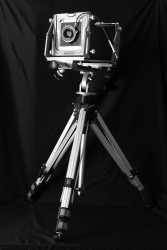>>4284642I mainly shoot tmax100 for 4x5, but I have a pack of foma to mess around with and let friends shoot, hah. I was looking at gp3, and the notching may be weird. You may be able to feel the emulsion side, but I would not be happy about using it because I am so used to the industry standard notching. You may get into a bad habit if the notching is non standard on gp3.
I have one of those sekonic spot/incident combo meters that works wonderfully. If I'm using one of my more modern shutters I almost never miss exposure with it. The problems arise when it gets cold or you're using an old shutter that has slowed down. You have to do some test shots or guesstimation to figure out the real shutter speed.
A lot of times I'll just look for a section in my scene that I want to be in the middle of my exposure and spot meter there. I will check the shadows and highlights to make sure it isn't too wide of an exposure, and then add or subtract a little depending on what is more important. I haven't gotten too deep into really utilizing the zone system because I'm lazy about developing my film.
It's very useful to have a depth of field calculator on your phone, reciprocity charts for your film, and a bellows extension compensation calculator if you're doing macro.
I was using a 10 inch extension and a 120mm lens earlier today, and the calculated bellows compensation was 2 full stops. The base exposure was 3 seconds, so it turned into 10 seconds, and then reciprocity turned that into a 15 second exposure!
Last little thing is focusing. There is a definite learning curve to focusing on a view camera. It can be tough because of the fresnel lens, and having to use a loupe.
Starting with 90-120mm lense will let you stop down and get to infinity from fairly close to the camera. Using the dof calculator takes focusing out of the equation for many types of shots.

